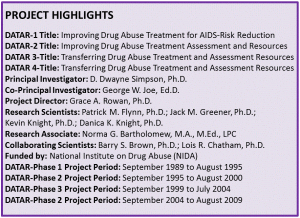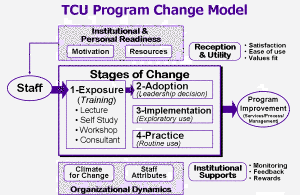
Counselor attributes and skills directly impact the client engagement process, but within the context of significant organizational dynamics increasingly recognized as needing additional research. Thus, the third 5-year phase of our DATAR project, entitled Transferring Drug Abuse Treatment and Assessment Resources (DATAR-3), was funded in 1999. The literature identifies major factors seemingly involved in transferring new treatment innovations into practice, but understanding how to do it more effectively needed attention. Incorporating these factors into an integrated framework is beginning to advance the scientific progress and practical contributions in this field, including development of assessments for client, staff, and organizational dimensions represented. These studies, for example, document that organizational climate is predictive of treatment satisfaction and counselor rapport. It is therefore important to address organizational climate issues, particularly in dysfunctional programs, as well as identifying specific client needs and changes in treatment regimens to help improve client functioning in treatment programs.
The original TCU Program Change Model integrated related observations from our research with the literature (see Figure 2). At the core of this heuristic framework are action steps typically involved in the process of technology transfer. Training and systematic exposure to new ideas usually come through lecture, self-study, workshops, or expert consultants. The second stage, Adoption, represents an intention to try an innovation. While this might be a “formal decision” made by program leadership, it also includes levels of commitment made by individual staff members about whether an innovation is appropriate at a more personal level and should be tried. Implementation comes next, implying that there is a period of trial usage to allow testing of its feasibility and potential. Finally, the fourth stage moves to Practice, reflecting the action of incorporating an innovation into regular use and sustaining it (even if it is in some modified form).
Each of these stages admittedly involves a series of smaller interrelated steps, and the literature identifies several important factors that influence this process and determine ultimately the extent to which the intended program changes occur. Simple innovations often can be adopted and successfully implemented in programs with only minor tremors in organizational functioning. As innovations and new procedures become more complex and comprehensive, however, the process of change becomes progressively more challenging—especially in settings where staff communication, cohesion, trust, and tolerance for change are low.
Organizational-level assessments are perhaps the most challenging because they require data to be taken from individuals within an organization (e.g., leaders, staff, clients) and then aggregated in ways that represent “the organization.” Selection of appropriate scales, data collection format, reliability and validity of measures, selection or sampling of individuals to properly represent the organization, and methodological alternatives for aggregating data are issues that require attention. TCU assessments of organizational needs and functioning have been created with these applications in mind. The TCU Client Evaluation of Self and Treatment (CEST) is used to measure client-level and program-level performance indicators in treatment. The TCU Organizational Readiness for Change (ORC) focuses on organizational traits that predict program change. It includes scales from four major domains—motivation, resources, staff attributes, and climate. Comparisons of scale scores from the CEST and ORC assessments with other programs have been made available by defining norms (e.g., 25th and 75th percentiles) based on large-scale databases at TCU. This type of information helps guide overall training efforts as well as predict which innovations participating programs are most likely to seek out and adopt.
DATAR Phase 3 Supplements
Health Disparities Among Minority Treatment Clients
(October 2002 to September 2004)
International Cross-Cultural Study of Organizational Functioning
(October 2002 to September 2004)
Development of an Organizational Readiness for Change Assessment for Correctional Substance Abuse Treatment Programs
(September 2003 to August 2004)
Summary. A series of supplements supported research on understanding of how organizational functioning may be related to health disparities among minority populations, crosscultural generalizability of the ORC in Italy and England, and the applicability of a revised ORC for assessment use for correctional settings.
With respect to health disparities, findings showed there were race-ethnic differences with regard to types of health problems reported. More importantly, health problems were related to psychosocial functioning and to treatment engagement and these relationships held when adjusted for race, gender and age. An Italian version of the ORC survey also was developed, and surveys from 341 respondents (representing 64 programs) were completed, primarily via the Internet. Results in the Italian Veneto Region revealed high similarities between organizational functioning profiles from U.S. and Italian programs. Psychometric analyses also showed reliabilities of the ORC/Italian scales were consistent with U.S. findings, and comments collected from survey respondents confirmed interpretations of ORC profiles.
Figure 2 needs to be updated (get from Julie?)

Reference
Simpson, D. D. (2002). A conceptual framework for transferring research to practice. Journal of Substance Abuse Treatment, 22(4), 171-182. [Abstract]